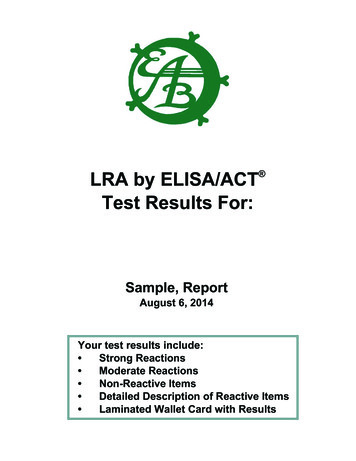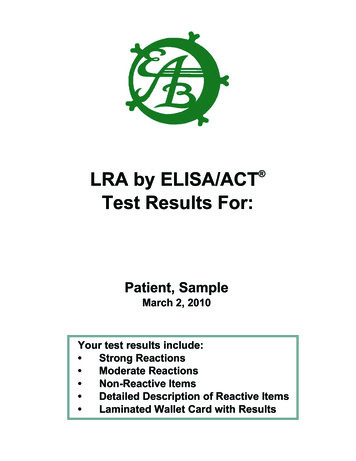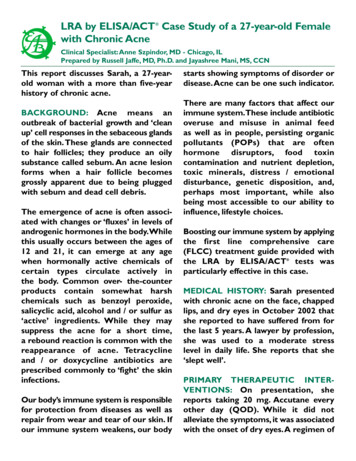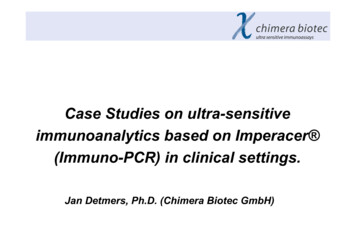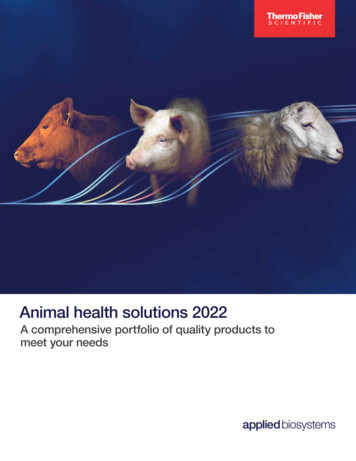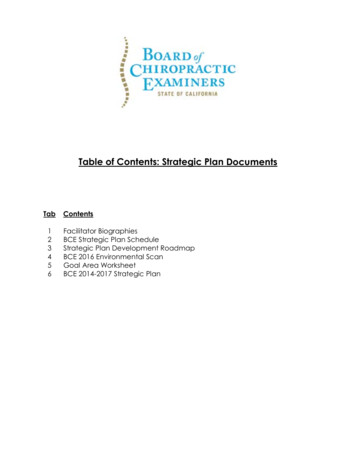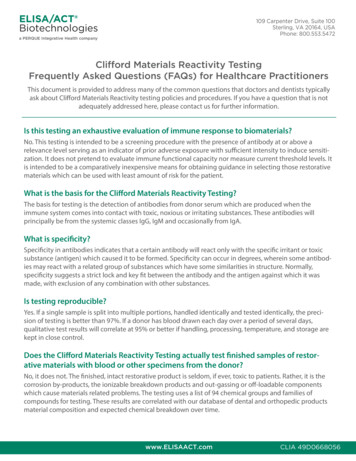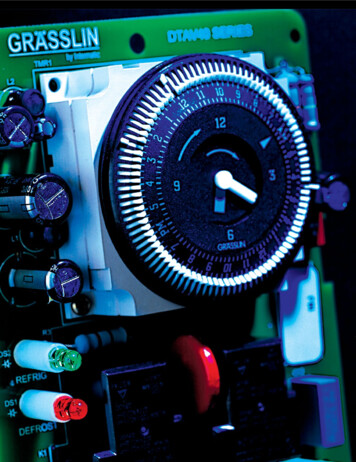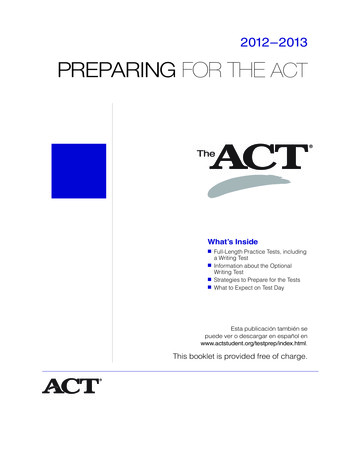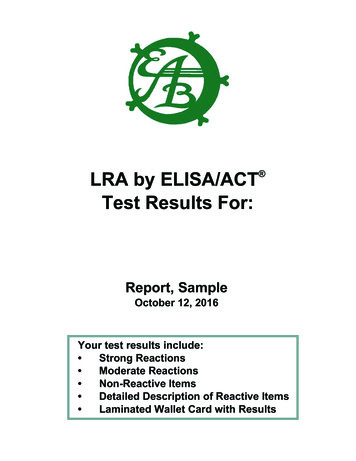
Transcription
LRA by ELISA/ACT Test Results For:Report, SampleOctober 12, 2016Your test results include: Strong Reactions Moderate Reactions Non-Reactive Items Detailed Description of Reactive Items Laminated Wallet Card with Results
ELISA/ACT LRA RESULTSSTRONG REACTIONSReport, Sample 78608October 12, 2016Avoid for at least 6 months. Grape Seed Oil Sulfite/Metabisulfite Caffeine Carmoisine Annatto 2-Methyl Pentane PenicillamineMODERATE REACTIONSAvoid for at least 3 months. Barley Oats Tea, Black Bean, Pinto/Frijole Yogurt (Cow) Chestnut Peppermint Arrowroot MSG (Monosodium Glutamate) Methyl paraben FD&C Yellow #5 Chlordane Vinyl Chloride Mushroom, Shiitake Water Ampicillin StreptomycinchestnutMODERATE FOOD GROUP(S): COW DAIRYButter (Whole)Cheese (Cow):BrickCottage CheeseParmesanProcessed CheeseLactalbuminLactoglobulinMilk (Cow):CaseinMilk, PasteurizedMilk, RawYogurtWheyThus of the 505 substances tested, reaction is noted to 24 items and 1 food group(s).While both strong and moderate reactions are equally burdensome to your immunedefense and repair systems, we have found that it takes about half as long to restoretolerance of moderate reactions as compared to the strong ones.Results1A
Report, Sample10/12/201678608ELISA/ACT LRA RESULTSNON-REACTIVE ITEMS 1, 2 Dichlorobenzene 2, 4, 5 T 2,4-D 3-Methyl Pentane Acai Berry Acesulfame Aduki/Adzuki Bean Agave nectar Aldrin Alfalfa Algae (Chlorella) Algae (Spirulina) Allspice Almond Aloe Alternaria alternata Aluminum Amaranth Amitriptyline (Elavil) Amoxicillin Anchovy Anise Seed Antimony Apple Apricot Arnica Arsenic Artemisia anua Artichoke Asparagus Aspartame/Nutrasweet Aspergillus fumigatus Aspergillus niger Aspergillus oryzae Aspirin/Coal Tar Astragalus Avocado Baking Powder Bamboo Banana Barium Sulfate Basil Bass Bay Leaf Bean, Garbanzo Bean, Kidney Bean, Lima Bean, Mung Bean, Navy Bean, Soya Bean, String/Wax Beef/Veal Beet Benzaldehyde Benzene Benzopyrene Benzyl Acetate Bergamot Beryllium Oxide BHA BHT Black Cohash Blackberry Bladderwrack Blueberry Bok Choi Botrytis cinerea Boysenberry Brazil Nut Brilliant Black Broccoli Buckwheat/Kasha Buffalo Butter, Clarified (Ghee) Cabbage/Brussels Sprouts Cadmium Calcium Propionate Camphor Camu Camu Candida albicans Cantaloupe/Honeydew Caraway Seed Carbamates Carbon Disulfide Carbon Tetrachloride Cardamom Carmine/Cochineal Carob Carrot Cashew Cassava (Yuca) Cat Dander (Felis cattus) Catfish Cauliflower Celery Cellulose/Hemicellulose Cephalexin (Keflex) Chamomile Chard Cheese, Romano (Sheep) Cheese/Milk (Goat) Cherry Chia Chicken Chicory Chive Chloroform Chrysanthemum Cilantro Cinnamon Ciprofloxacin (Cipro) Cis-Dichloroethylene (1, 2 Cladosporium cladosporioides Cladosporium herbarum Clam Clarithromycin (Biaxin) Clove Coconut Cod Liver Oil Codfish Collard Greens Coriander Corn (Maize) Cottonseed Oil Crab Cranberry Cream of Tartar Cucumber Cucumber, JapaneseResults1B
ELISA/ACT LRA RESULTSReport, Sample10/12/201678608NON-REACTIVE ITEMS, CONT'D Cumin Currant Curry Cyclohexylamine D & C Green #5 D & C Orange #5 D & C Red #33 D & C Violet #2 D&C Orange #4 Date DBCP (1,2 Dibromo-3-chloropropane) DDT Deer/Venison DEET Detergent (Synthetic) Diacetyl (2,3-Butanedione) Diazepam (Valium) Dibutyl Phthalate Dieldrin Dill Docosanol (Abreva) Dog Dander (Canis familiaris) Dong Quai Dragon Fruit Duck Feathers (Anas platyrhynca) Duck/Goose Dulse Echinacea EDTA Egg White (Chicken) Egg Yolk (Chicken) Eggplant Elderberry Endive Endrin Ephedra Epicoccum nigrum Epidermophyton floccosum Erythromycin Ethyl Acetate Ethyl Acetoacetate Ethyl Butyrate Ethyl Mercury Ethylene Dibromide FD&C Blue #1 FD&C Blue #2 FD&C Green #3 FD&C Red #2 FD&C Red #3 FD&C Red #40 FD&C Yellow #10 FD&C Yellow #6 Feverfew Fig Flaxseed/Linseed Oil Fluconazole (Diflucan) Formaldehyde Fusarium solani Fusarium vasinfectum Garlic Gelatin Geotrichum candidum Gin (Juniper Berries) Ginger Ginseng, American Ginseng, Chinese Ginseng, Siberian Gliadin Gluten Glyphosate Goat Hair/Skin Scraping (Capra hircus) Goji Berry Gold Goldenseal/Hydrastis Goose Feathers (Anser anser) Gooseberry Grape/Raisin, Green Grape/Raisin, Red Grapefruit Guaifenesin (Mucinex) Guinea Pig Hair (Cavia porcellus) Gum, Acacia Gum, Agar Gum, Carrageenan Gum, Guar Gum, karaya Gum, Locust Bean Gum, Tragacanth Gum, Xanthan Haddock Halogenated Biocide Hawthorne Hazelnut/Filbert Helminthosporium halodes Helminthosporium sativum Hemp Heptachlor Hexachlorocyclohexane Hijiki Honey Hops Horse Dander (Equus caballus) Horseradish Hydrogenated Oil Hydroxychloroquine (Plaquenil) Hypericum/St. John's Wort Ibuprofen Irish Moss Isopropyl Ether Kale Kamut Kelp/Sea Weed Kiwi Kombu Lamb/Mutton Latex Lead Leek Lemon Lemongrass Lentils, Red, Green Lettuce, Iceberg Lettuce, Red Leaf Lettuce, Romaine Licorice Lime Lobster Lomatium MacaResults2B
ELISA/ACT LRA RESULTSReport, Sample10/12/201678608NON-REACTIVE ITEMS, CONT'D Macadamia Mace Magnesium stearate Maleic Anhydride Malt Mango Mannitol Marjoram Menthol Mercury Mesalamine (Asacol) Metallic Catalysts Methoxychlor Methyl Mercury Methylene Chloride (Dichloromethane) Methylphenidate (Ritalin) Millet Miso, Barley Miso, Brown Miso, Hatcho Miso, White Molasses Morpholine Mucor mucedo Mucor racemosus Mushroom Mushroom, Maitake Mushroom, Reishi Mustard Greens, Spice Naproxen Nectarine Nickel (II) Chloride Nitrates/Nitrites Nitrosamine Mix Noni Nutmeg Nystatin Okra Olive Omeprazole (Prilosec) Onion, Yellow Orange Oregano Organophosphates Oyster Palm Oil Papaya Paprika Parsley Parsnip Pea, Black-Eyed Pea, Green, Snow Peach Peanut Pear Pecan Penicillin Penicillium notatum / chrysogenum Penicillium roqueforti Pentachlorophenol (PCP) Pepper, Black Pepper, Cayenne Pepper, Chili, Red Pepper, Green, Red, Yellow Pepper, White Perch/Mackerel Petroleum By-Products & Solvents Phenol Phthalates Pimiento Pineapple Pinene Piroxicam (Feldene) Pistachio Plum, Umeboshi Plum/Prune Polyethylene glycol Polysorbate 20 Polysorbate 60 Polysorbate 80 Polyvinylpyrrolidone Pomegranate Ponceau 2R Ponceau 4R Poppy Seed Pork/Bacon/Ham Potassium Bromate Potassium sorbate Potato, Sweet Potato, White Primrose Oil Propyl Gallate Propyl paraben Propylene Glycol (1,2-Propanediol) Psyllium Seed Pullularia pullulans Pumpkin Pyrene Quail Quinoa Rabbit Rabbit Hair (Oryctolagus cuniculus) Radish Rapeseed/Canola Oil Raspberry Resin Rhizopus nigricans / stolonifer Rhodotorula Rhubarb Rice, Basmati Rice, Brown Rice, White Rice, Wild Rose Hips Rosemary Royal Jelly Rutabaga Rye Saccharine Safflower Oil Saffron Sage Salicylate Salmon/Lox Sardine Scallion/Spring Onion Scallop Scopulariopsis brevicaulis Sea LettuceResults3B
ELISA/ACT LRA RESULTSReport, Sample10/12/201678608NON-REACTIVE ITEMS, CONT'D Selenium Sulfide Sesame/Tahini Sheep Wool (Ovis aries) Shrimp Silicates / Silicon Dioxide Silicone Silver Slippery Elm Snapper Soap (SDS/SLS) Sodium alginate Sodium Benzoate Sodium erythorbate Sodium Fluoride Sodium Propionate Sole/Flounder/Halibut Sorbitol Spearmint Spelt Spinach Splenda (sucralose) Squash Star Fruit Stemphylium botryosum Stevia Strawberry Sugar Cane / Sucanat Sugar, Beet Sugar, Corn Sugar, Maple Sunflower Swordfish Tamari Tamarind Tangerine/Mandarin Orange Tapioca Tarragon Tert-Butyl-Ethyl Ether (TBEE) Tert-Butyl-Methyl Ether (TBME) Tetrachloroethylene Tetracycline Thricothecium roseum Thyme Tilapia Tin/Stannous Chloride Titanium Dioxide Tobacco Tofu Toluene Tomato Trichloroethylene (TCE) Trichoderma harzianum Trichophyton mentagrophytes interdigitale Trichophyton rubrum Triticale Trout Tuna Turbot Turkey Turkey Feathers (Meleagris gallopavo) Turmeric Turnip, Greens Tylenol (Acetaminophen) Valerian Vanilla Vegetable Glycerin Wakame Walnut Oil, Black Walnut, English Watercress Watermelon Wheat White Willow Bark Xylene Xylitol Yaki Nori/Laver Yeast, Baker's (S. cerevisiae) Yeast, Brewer's (S. cerevisiae)Results4B
Report, Sample 78608October 12, 2016LRA by ELISA/ACT Tests Results and What They MeanLRA by ELISA/ACT tests use a breakthrough technology that allows the laboratory, for the first time, to observeimmune reactions of specialized white cells (lymphocytes) just as they occur in your body (ex vivo, to be technical).Live lymphocytes from your blood sample are exposed to antigens in our lab. Reaction indicates loss of tolerance anddevelopment of self-attack known as delayed hypersensitivity. Strong reaction means that 50% of cultured lymphocytes react. Moderate reaction means that 5-50% of cultured lymphocytes react.Complete food group(s) will be displayed as reactive when two or more foods in that group are reactive. Dairy, because itis commonly cross-allergenic, is the only exception. The dairy group will appear in bold if even one item in the dairygroup is reactive. It is recommended to avoid all items in a food group if it is listed in bold.Reactive items are an adverse load on your body’s immune defenses. This means a reduced ability to respond to new orchronic infections. Reactive items also decrease immune activities needed to repair your body. This can provokeinflammation and self-attack ("autoimmunity").Avoid strong reactors for six (6) months and moderate reactors for three (3) months to reduce the burden on theimmune system and restore your body’s ability to repair. Avoiding reactive items can break the cycle of impaired defenseand repair, allowing your body to start the recovery and repair process.Immediate allergies (Type 1 IgE linked) are not detected by the LRA by ELISA/ACT tests. Immediate allergies areusually detected by history, routine skin tests, or RAST tests. If you have known immediate allergies, you should continueavoiding those items. Consult with your health professional if you have any questions regarding your immediateallergies.LRA by ELISA/ACT Tests Are DifferentThe LRA tests identify only reactive lymphocytes. B class lymphocytes react to harmful antibodies; T classlymphocytes react directly.Protective memory (non-reactive IgG) antibodies do not provoke symptoms and are not detected by ELISA/ACT LRAtests. Detecting only the items that provoke reactions is an advantage of lymphocyte response assays.Other antibody tests (ELISA IgG, EIA IgG, IgG tests) do not offer this advantage. These tests measure only if antibodiesare present. Since antibodies can be helpful or harmful, knowing the amount of an antibody tells nothing of its function-does it protect and help or does it react and harm?Some labs measure particles and assume all particles of a certain size are reactive lymphocytes—again, thesemeasurements are not as helpful as the LRA by ELISA/ACT tests.MD, Ph.D., FASCP, FACAAI, FACNReferences: Golub, E.S. Immunology: A synthesis Sinauer Associates, Inc. , Sunderland, MA 1987 p474-479. Sell, S. Immunology,Immunopathology, and Immunity, 4th Ed., Elsevier, NY, 1987 p 314-321. Jaffe, R. Improved Immune Function Using Specific NutrientSupplementation and ELISA/ACT “Immunologic Fingerprint” to Detect Late Phase Responses Ex Vivo. J Am Col Nutr 8(5): 424, 1989.
Report, Sample 78608NameAmountNutritional RecommendationsTimes10/12/2016Action/UseSpecial CommentPriority Supplements:PERQUE LIFETwo tabsulesGUARD Multivitamin (4 if using PERQUEmultimineral/Lifeguard mini)transporter enhancedw/o ironPERQUEPotent CGUARDAscorbate(buffered Vitamin C)Powder or tabletsOnce a day with Provides essential vitamins and minerals inmeal/s ofthe most bio-absorbable and bio-availablechoice.Total forms, for optimal metabolic functioning .of 2 ( 4 mini)Depends on amount Four or morebody will absorbtimes a day(determined by theAscorbate calibrationprotocol)Energizing and alkalinizingformula : enhances andprotects the immune systemCentral regulator of cell metabolism, astimulant to structural connective proteinsynthesis, & is vital to repairRefer to the Ascorbate(Vitamin C) Calibrationprotocol that will helpdetermine the body's needfor Vitamin C . This is alsoon Page 98 in The AlkalineWay GuidePERQUE PAIN4 tabsulesGUARD FORTÉ,500mg. Quercetin with 5mg. of (OPC soluble)ProanthocyanidinsTwice a day ;total of 8This flavonoid and flavanol combinationimproves utilization of Vitamin C; reduceschronic viral activity and decreasesinflammation.Best taken in conjunctionwith ascorbate.PERQUE DIGESTA 1-2 capsulesGUARD FORTÉ1-2 capsules(Synergy of 91 capsulebeneficial probiotics)With all meals:for 1monthWithbreakfast&dinner : for 2 monthsWith breakfastonly, after 3monthsRebuilds healthy digestive flora in theintestinal tract. Inhibits the growth ofpathogens . Promotes better overalldigestionAfter 6 months from start oftherapy a stool culture ofmicroflora (intestinal bugs)is recommended. Pleasesee your healthcareprofessional to obtain furtherinformation.Unique antioxidant 1 capsulecomplex : Promotesliver healthBreakfast &dinnerHelps restore liver function.Use for 3 months andrecheck liver enzymeactivity.PERQUE1 sublingual lozenge 3 times a day ( 3 Improves methylation detoxification andHydroxocobalamin is theACTIVATED B12lozenges/day) reduces cell susceptibility to stress injury.preferred form of B-12 andGUARDAlso, improves transport of biochemicals and is suitable for vegetarians. If(Oral Vitamin B12 asreduces reactivity of muscle fibers. Besthomocysteine levels arehydroxocobalamindissolved under the tongue, not swallowed. monitored, sufficient intakefor energy andto reduce levels 6 mg/dl isdetoxification)recommended.Supplements1
Report, SampleNameNutritional RecommendationsAmountTimesAction/UseSpecial CommentSpecific supplements that may be helpful:PERQUE CHOLINE 1300 mg. (1CITRATE ( uniqueteaspoon) diluted inliquid performance- juice or waterenhancing formulafor body and mind)Breakfast &dinner.Improves cell membrane communication&bile acid production.Choline citrate is fivefoldmore active than cholinebitartrate.Choline Bitartrateis also likely to be antigencontaminated,Coenzyme Q10micellized with purerice bran oil60 mg.Twice a dayImproves cell electron transport andincreases energy production in the cell.Improves heart /musclehealth and energyPERQUE TRIPLEEFA GUARDEssential FatsOmega 3,6,9 DHAEPA CLA2 softgelsThree times aday : total of 6Omega 3 reduces plaque formation.Omega 6 decreases inflammationOmega 9 enhances membrane fluidity.Essential Fatty Acids in theright proportions forimproved healthPERQUE2 softgelsMETABODETOXPLUS (MDP)GUARDEnhanced fatmetabolizers:Carnitine fumarateMCT, GABA & KelpAlginate4 times a day :Total of 8Provides effective fat metabolism; givesexercise benefits; controls appetite. Alsoimportant for heart muscle functionThis is a potent formula,with convenient dosage andlasting resultsPERQUE3 capsulesENDURA/PAKGUARD L-Glutamine PyridoxylAlphaketoglutarate("PAK")Twice a dayGives body energy, supports mentalsharpness, helps regenerate the intestinalsurface cells.PAK recycles L -glutamineand prevents glutamate build up.Take on empty stomach, i.e1/2 hour before a meal / 2hours after meals or atbedtimePERQUE MOODGUARD : Balancesbrain chemistry :Magnesium LAspartate, Glycine,L-Methioninecombination.Twice a day 30 Detoxifies the body, alleviates mild to-60 minutesmoderate depression, regulates sleepbefore eatingrhythms.(empty stomach)Total 42 capsulesClinically superior to SAMeSupplements2
Report, SampleNameNutritional RecommendationsAmountTimesAction/UseSpecial CommentPERQUE ADRENO 2 soft gelsDISTRESS GUARD:Nature'scomprehensivestress relief :Rhodiola, Magnoliaand PhellodendronTwice a dayNeutralizes stress, balances cortisol andrebuilds hormone functionStore product below 70 F.PERQUE GLUCOSE 2 tion :Twice a daywith meals:Total of 4Regulates blood sugar levels and energybalance , decreases insulin resistance,decreases hormonal dysregulationLowers body weight whileincreasing lean body massPERQUE JOINT3 capsulesGUARD :Potent jointpain relief withGlucosamine,Chondroitin, OPCTwice a dayFacilitates joint cartilage repair and renewal, OPC and Molybdenum arereduces pain and increases joint mobility.unique ingredients to thisformula ; they additionallyprovide powerful nutritionprotection for the jointSuper Echinacea1 tablespoon (15cc) 5 days a week,(alcohol tincture) or in 4 oz. water orfor 12 monthsEchinacea Glyceride juice.(e.g. Mon-Fri)(glycerol extract)Boosts immune system function. Particularly Take on empty stomach 1/2T-helper cells and the production of immune hour before meal.May bestimulating chemicals like interferon.added to ascorbatebeverage.Liquid Nutrient PlanUp to full amount tofeel satisfied.One day eachweekProvides easily assimilated nutrients withRefer to the Liquids-Onlyminimum work by digestive system, so repair Nutrient Sufficiency Plan :can occur.page 94 in The AlkalineWay Guide for moreinformationPanax GinsengextractOne ampule1/2 hour before Enhances adaptation to distress.lunch.Charcoal capsules or 1 or 2 capsules ortabletstablets.After breakfast, Absorbs excess formed gas.lunch, dinner. Asneeded for gas.L-HistidineFour times a day Decreases inflammation & increases body's Take on empty stomach 1/2NOT with meals pool of electron trapping chemicals.hour before meals or 2hours after meals.600 mg.Take after meals only ifneeded for 'gas control'.Supplements3
Report, SampleNameGinger TeaNutritional RecommendationsAmountTimesAction/UseSpecial CommentAdd a fresh 1 inchAs beverage of Enhances detoxification;restores glutathione Honey or organic cane juicesize piece of minced choiceproduction ;enhances digestionmay be added to taste.ginger into 8 oz. ofboiling water.Supplements4
Report, Sample 78608Behavioral Recommendations10/12/2016Learn new patterns of consumption. You may want to read Diet for a Small Planet by Frances Moore Luppe, Diet andNutrition by Rudolph Ballantine, MD., Minding the Body, Mending the Mind by Joan Borysenko, PhD., and Acid andAlkaline by Herman Aihara.Take balanced and fully active nutritional supplements as recommended in this report. Your health professional, orthe sources cited in this report, can provide ordering information.Demonstrate your commitment to your health as an essential part of your life by performing each and every part ofthis report as recommended by your physician with full attention.Learn abdominal breathing and practice it for a few minutes once or more each day. Abdominal breathing meansactively filling the abdomen as though it were a balloon being filled. Next allow the balloon to slowly passively deflate.Repeat for the full five minutes twice daily.Discuss the meditation technique that is best for you with your doctor. Active Meditation: the Western Tradition byRobert R Leichtman, MD and Carl Japikse is an example of a non-sectarian, non-denominational approach to evokingyour healing response, and is distinctly helpful.Combine foods according to Food Combining for Better Digestion in order get the most efficient assimilation ofnutrients from the foods you eat. This is Page 19 in the Alkaline Way Guide.Have your digestion evaluated by a Comprehensive Stool Analysis.Use special, biologically active dichromatic green lights. These are known as PAR38 ( 150 watt green) and are madeby GE and Sylvania. These are available from Thinking of You at 800-806-8671. Direct the light at the face from adistance of about 5 feet for about 20 minutes daily: before bed and on rising are particularly good times. Refer to LightTherapy: Page 109 in the Alkaline Way Guide.Exercise using the rebounder-type trampoline for 15 minutes twice a day . Rebounder-type trampolines can bepurchased at your local sporting goods store. Refer to Distress Busting: Central Health Promoting Actions Rebounder Trampoline: Page 106 in The Alkaline Way GuideTake a daily salt and soda bath. The Epsom salt ( Magnesium Sulfate) electrolyte improves the electrical conductivityof the skin and the alkaline baking soda helps rid the skin of acid residue deep in the pores. Put one half cup each ofEpsom salts and baking soda in a tub of warm (not hot) water. Soak for 10-15 minutes and shower thereafter, gentlyrubbing the skin with a loofa. Refer to Distress Busting: Central Health Promoting Actions - Salt and Soda Baths formore information: Page 91 in The Alkaline Way GuideReceive traditional acupuncture [6-8 sessions to determine effectiveness] from a traditional acupuncturist near you.Ask your physician for a referral.Healthy Habits1
Report, Sample 78608Description of Items:October 12, 2016Grapeseed OilHistory/Discussion: Grapeseed oil has half the saturated fat of olive oil. It is rich in antioxidants and has a high smoking point (thetemperature must get very high before it begins to chemically decompose).Sources of Exposure: Grape seed oil is used for: salad dressings, marinades, deep frying, flavored oils, baking, massage oil,sunburn repair lotion, hair products, body hygiene creams, lip balm and hand creams.Substitutions: Other oils like sunflower, safflower, peanut, sesame, and canola (assuming that you do not react to them).Sulfite/MetabisulfiteItems Tested: Sulfiting agents are used for a variety of preservative properties including controlling microbial growth,preventing browning, spoilage and bleaching of some foods. Six sulfiting agents are currently considered by the FDA tobe safe as chemical preservatives. These are sulfur dioxide, sodium sulfite, sodium and potassium bisulfite and sodiumand potassium metabisulfite.History/Discussion: Sulfites have been used for many years in foods and pharmaceuticals. They were approved for usein the US as long ago as the 1800's. In recent years, however, the safety of sulfites in foods and drugs has beenquestioned. Sulfites can cause severe allergic reactions in sensitive individuals resulting in breathing difficulties,wheezing, asthma, hives, severe itching, nausea, vomiting, diarrhea, abdominal pain and cramping, headaches and, insome cases, anaphylactic (allergic) shock and death. Asthmatics, especially steroid-dependent asthmatics, areparticularly sensitive to sulfites. Some 10 percent of the population is asthmatic and an estimated 2 to 10 percent of allasthmatics are sulfite-sensitive and are at marked risk for severe reactions. Not all sulfite-sensitive people areasthmatic, but asthmatics are at greatest risk for severe reactions. Vitamin B12 and molybdenum may be helpful indecreasing one's reactivity to sulfites, but should not replace avoidance. In almost all applications, erythroate andascorbate can be substituted, avoiding sulfite risk.Sources of Exposure: Sulfites and metabisulfites may appear as sulfite, sodium or potassium metabisulfite, sodium orpotassium bisulfite, sodium sulfite, or sulfur dioxide in ingredient listings. Common sources of exposure (always readlabels) include alcoholic beverages (wine, beer, cocktail mixes, wine coolers), baked goods (cookies, crackers, mixesincluding dried fruits or vegetables, pie crust, pizza crust, quick crust, flour tortillas), beverage bases (dried citrus fruitbase, bottled beverages, mixes, cider, root beer), condiments (horseradish, onion and pickle relishes, pickles, olives,salad dressing mixes, wine vinegar), confections, frostings and fillings (brown, raw, powdered or white sugar derivedfrom sugar beets, fruit fillings, gelatin, pectin, jelling agents), dairy product analogs (filled milk - skim milk enriched in fatcontent by addition of vegetable oils), fish and shellfish (fresh, frozen, canned or dried shrimp, frozen lobster andscallops, canned clams, dried cod), processed fruits and vegetables (canned, bottled or frozen juices; canned, dried,frozen or pickled fruits or vegetables; jams and jellies, maraschino cherries, shredded coconut, instant mashedpotatoes, potato salad), soy protein products, trail mixes, canned or dried soups or mixes, sweet sauces or syrups (cornsyrup, high-fructose corn syrup, maple syrup, pancake syrup, molasses, fruit toppings), and teas (instant or liquidconcentrates).1
Report, Sample 78608Description of Items:October 12, 2016CaffeineItem Tested: Caffeine is an odorless, white powder with a bitter taste that occurs naturally in coffee, cola, guaranapaste, tea and kola nuts.History/Discussion: Caffeine is the number one psychoactive drug in the US.Consumption of caffeine in considerable amounts can lead to various adverse health effects including: Over-arousal of the nervous system causing irritability, insomnia, anxiety, & panic attacks Rebound tiredness and fatigue, especially in sensitive individuals Increased blood pressure (hypertension) Increased heart rate (tachycardia) and arrhythmias (Paroxysmal Atrial Tachycardia, PAT) Increased serum cholesterol levels Decreased immune function (animal studies) Fibrocystic breast diseaseSources of Exposure: Caffeine is a common ingredient in many over-the-counter and non-prescription medications aswell as being a component of coffee, tea, cola, chocolate/cocoa, guarana, and many sodas (see list below).Items Commonly Containing CaffeineCoffee, 7 oz (207 ml)80 - 135 mgDecaf3 - 4 mgEspresso, 1 shot, 1.5 - 2 oz (44 - 59 ml)100 mgTeaIced, 12 oz (355 ml)70 mgBrewed40 - 60 mgCocoaChocolate, Cadbury, 1 oz (28 g)15 mgChocolate Milk, 8 oz (237 ml)8 mgHot cocoa mix, 1 pkg5 mgSoda, 12 oz (355 ml)Coca-Cola and Diet45.6 mgPepsi37.2 mgDiet Pepsi35.4 mgDr. Pepper39.6 mgMountain Dew55.0 mg (0 mg in Canada)Jolt71.2 mgExcedrin65 mgVivarin200 mgGuarana5% by weight, 25 mg caffeinein 500 mg of whole guarana seedSubstitutions: Coffee alternatives include hot spring or purified water with lemon, ginger tea, herb teas and fresh juice.2
Report, Sample 78608Description of Items:October 12, 2016CarmoisineItem Tested: Carmiosine, a red coloring agent. Also called Azorubine, Acid Red 14, Azorubin, Brilliant carmoisineHistory/Discussion: Carmoisine is a bluish-red coloring and used widely in the UK.In the United States it is not allowed in foods, drugs or cosmetics but is used in technical applications as a coloringagent for cleaners, marking pens, water colors, poster paints and the like. It is used in foods in Mexico and SouthAmerica as well as parts of Asia. Carmoisine is banned in the US, Canada, Japan, Norway and Sweden. The UK is inthe process of trying to ban this colorant and many food manufacturers are voluntarily removing it from their products. Itis a water-soluble color.Sources of Exposure: Carmoisine may be consumed in foods made in the various countries where it is still allowed,such as Mexico, much of South America and parts of Asia. It is found in soda, marzipan products, jams, preserves, jelly.Exposure to carmoisine also comes from the use of water colors, poster paints, marking pens, etc.Substitutions: Any non-reactive coloring agent.AnnattoItem Tested: Annatto, sometimes called Roucou,History/Discussion: Annatto is a derivative of the achiote trees of tropical regions of the Americas, used to produce a redfood coloring and also as a flavoring. Its scent is described as "slightly peppery with a hint of nutmeg" and flavor as"slightly sweet and peppery". Annatto is produced from the reddish pulp which surrounds the seed of the achiote (Bixaorellana L.). Annatto is commonly found in Latin America and Caribbean cuisines as both a coloring agent and forflavoring. Central and South American natives use the seeds to make a body paint, and lipstick. For this reason, theachiote is sometimes called the lipstick-tree. Achiote, otherwise referred to as annatto or the Lipstick tree, originated inSouth America and has spread in popularity to many parts of Asia. It is very popular in Philippine cooking. It grows as adense small tree or shrub. The heart shaped fruits are brown or reddish brown at maturity, and are covered with shortstiff hairs. When fully mature the fruits split open exposing the numerous dark red seeds. While the fruit itself is notedible, the orange-red pulp that covers the seed is used as a commercial food colouring and dye (similar to turmeric).The achiote dye is prepared by stirring the seeds in water, and is popular in South America and Asia. In the PhilippineIslands the seeds are ground and used as a condiment. Annatto provides a bright and exotic appearance for many kindsof dishes. It is also used in cosmetics and textile manufacturing. Note: Because it is a natural colorant companies usingannatto may label their products "all natural" or "no artificial colors".Sources of Exposure: It is used in many cheeses (e.g., Cheddar, Red Leicester, and Brie), margarine, butter, rice,smoked fish and custard powder. May also be used to color rice, desserts, and other foods.Substitutions: Any of the non-toxic natural colors from food and/or plants.3
Report, Sample 78608Description of Items:October 12, 20162-Methyl PentaneItem Tested: Pentanes are aliphatic solvents and are taken almost exclusively from crude oil. 2-methyl pentane has sixcarbons in its molecule and is almost always found associated with another six carbon molecule, hexane. Isohexane is asynonym for 2-methyl pentane.History/Discussion: 2-Methyl pentane affects our bodies in many ways. On our skin it causes irritation, redness,swelling and changes in the underlying color. It damages nerves, which causes weakness and numbness of hands andfeet and difficulty walking, and has a narcotic-like effect when it accumulates in the body. It causes irritation of our eyesand the linings of our mouth and lungs. Most commonly, the highest level of exposure to 2-methyl pentane occurs in theworkplace. People who are sensitive to chemicals, however, have been noted to have toxic levels in their bodieswithout occupational expo
ELISA/ACT LRA RESULTS October 12, 2016 Report, Sample 78608 STRONG REACTIONS Avoid for at least 6 months. Grape Seed Oil Sulfite/Metabisulfite Caffeine Carmoisine Annatto 2-Methyl Pentane Penicillamine MODERATE REACTIONS Avoid for at least 3 months. Barley Oats Tea, Black Bean, Pinto/Frijole Yogurt (Cow) Chestnut Peppermint Arrowroot MSG .
